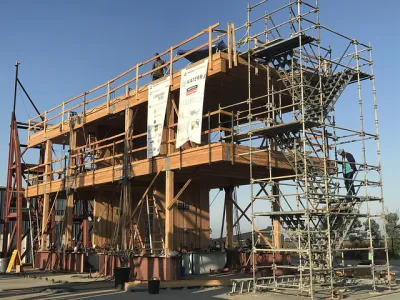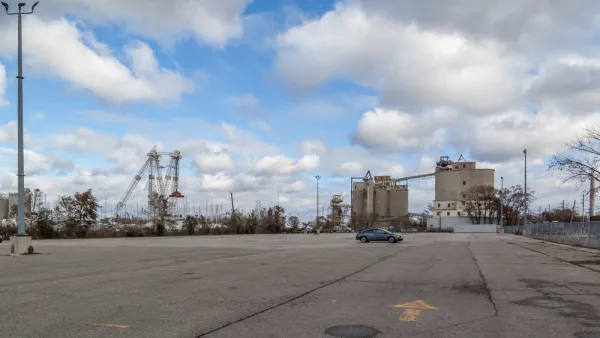Quayside, Sidewalk Labs' smart city in Toronto, calls for ten tall buildings made entirely of wood. Here's why proponents think mass timber is a good idea, and what obstacles stand in its way.

"In most U.S. cities, mass timber buildings, and specifically tall mass timber buildings, are a rarity, if they exist at all," Kira Barrett writes. But Sidewalk Labs' ambitious plan for a Toronto smart city called Quayside includes plans for ten of them. Barrett discusses the nature of the building material, which often consists of cross-laminated timber (CLT) panels, and its pros and cons.
To begin with the positives, proponents cite mass timber's capacity for carbon sequestration: one advocacy organization argues that a site with no building at all has a higher carbon footprint than one with a CLT structure. Mass timber buildings also weigh less than concrete and steel, reducing risk during seismic events.
But several factors hold mass timber back, the most obvious being the perception that wooden buildings are more prone to fire damage (even though engineered wood such as CLT mitigates some of that risk). There's also the question of access to timber for cities far from forests, the need to build out CLT production facilities, and a general lack of familiarity with the material on the part of architects and designers.
Its novelty means mass timber isn't included in the International Building Code, meaning that "construction with this material currently involves years of research, development and testing to make special state and city exceptions, on top of the already intensive construction process."
FULL STORY: Sidewalk Labs is building a smart city entirely of mass timber. What could go wrong?

National Parks Layoffs Will Cause Communities to Lose Billions
Thousands of essential park workers were laid off this week, just before the busy spring break season.

Retro-silient?: America’s First “Eco-burb,” The Woodlands Turns 50
A master-planned community north of Houston offers lessons on green infrastructure and resilient design, but falls short of its founder’s lofty affordability and walkability goals.

Delivering for America Plan Will Downgrade Mail Service in at Least 49.5 Percent of Zip Codes
Republican and Democrat lawmakers criticize the plan for its disproportionate negative impact on rural communities.

Test News Post 1
This is a summary

Test News Headline 46
Test for the image on the front page.

Balancing Bombs and Butterflies: How the National Guard Protects a Rare Species
The National Guard at Fort Indiantown Gap uses GIS technology and land management strategies to balance military training with conservation efforts, ensuring the survival of the rare eastern regal fritillary butterfly.
Urban Design for Planners 1: Software Tools
This six-course series explores essential urban design concepts using open source software and equips planners with the tools they need to participate fully in the urban design process.
Planning for Universal Design
Learn the tools for implementing Universal Design in planning regulations.
EMC Planning Group, Inc.
Planetizen
Planetizen
Mpact (formerly Rail~Volution)
Great Falls Development Authority, Inc.
HUDs Office of Policy Development and Research
NYU Wagner Graduate School of Public Service




























